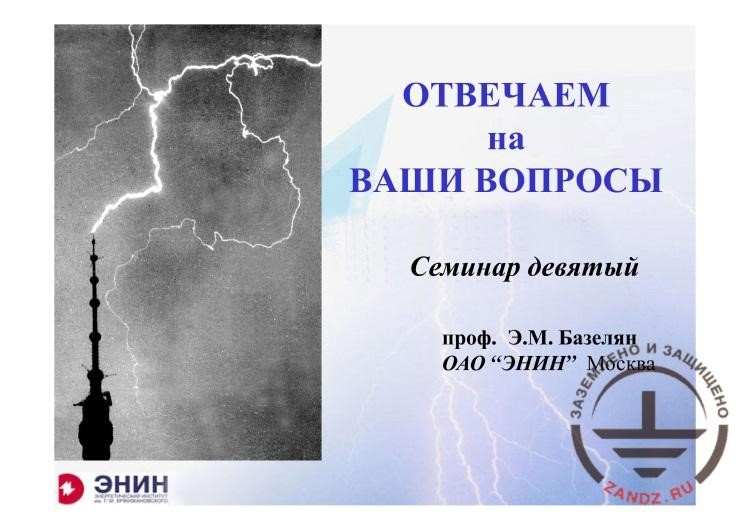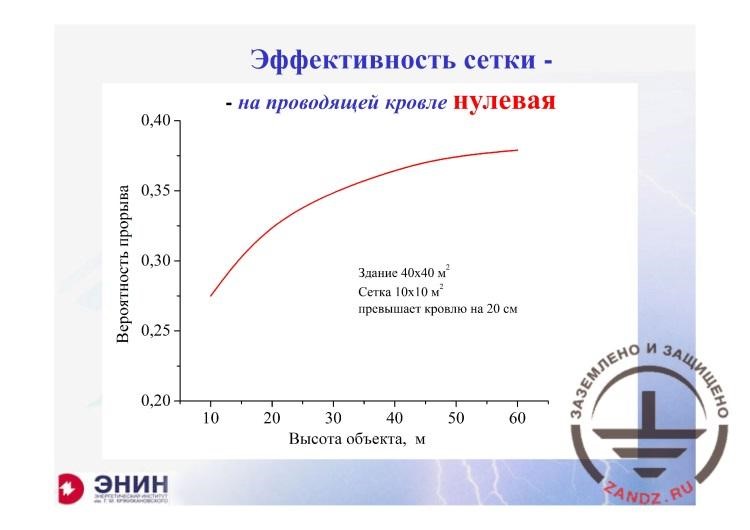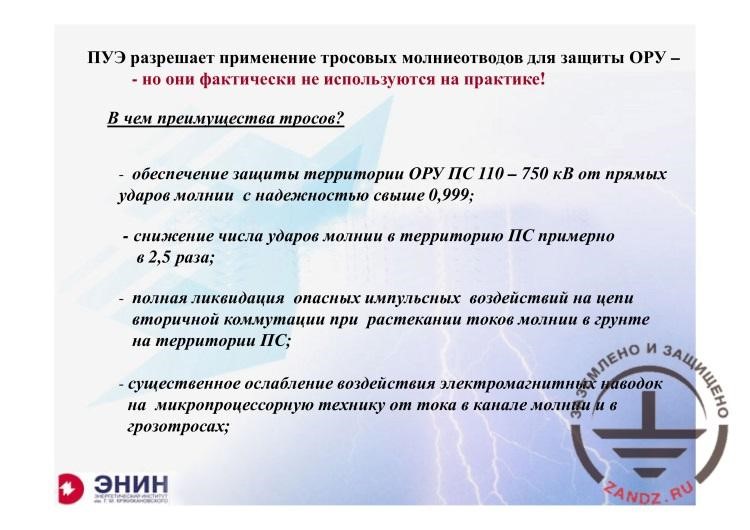The ninth webinar of "Earthing and Lightning Protection: Design Issues and Problems" series
(held on June 24, 2015 at 11:00 Moscow time)
The webinar is intended for: designers, construction electricians, operating service technicians
Venue: online (you will need the Internet access on your PC)
Fee: free of charge
Duration: 60 to 90 minutes
1. Power engineering facilities and substations:
- Arrangement and structure of lightning arresters on buildings having reinforced concrete roofs and walls finished with sandwich panels located on EPS (sometimes, capital walls behind sandwich panels are missing). Calculation method.
- External earthing to EPS. Calculation method (no software).
2. Telecommunication facilities:
- Design of lightning protection and earthing for the server rooms and data centres.
- Design of lightning protection and earthing of the antenna and mast structures.
3. Sensitive medical equipment:
- Why is a separate earthing circuit not required for the process medical equipment?
- Features of earthing design for the ultra-sensitive devices.
4. Lightning protection of residential buildings:
- Lightning protection of public and residential buildings with accessible roofs (a pool or a cafe is located on the roof, etc.).
- How do you recommend to make the lightning protection for the helipads located on the roofs of high-rise buildings?
5. Other issues and ideas for discussion
- In this case, potentials equalizing in a building, primary and secondary, is of interest.
- Lightning protection of gas turbine units.
- Features of design of earthing devices for the complexes of the liquefied natural gas (LNG) production, including stationary and mobile car and railroad filling stations.
720p full screen watching is recommended.
Webinar text. Page 1
Fast navigation by slides:
Page 1:
1. Answer to your questions
2. Reinforced concrete foundation as an earthing device
3. Considering a double-layer soil according to GOST 12.1.030-81
4. Protection of substation against direct lightning strikes
5. Grid efficiency
6. What are the wire advantages?
7. Multi-wire lightning protection for the open distribution devices' substations
8. Using sandwich panels for raining the lightning current
9. Design of earthing and lightning protection for 110–330 kV substations
Page 2: >>
10. Grids of large areas
11. Arrangement of grid earthing buses according to the EIC
12. Galvanic coupling between earthing devices
13. Lightning protection of communication facilities
14. Isolated lightning protection of antenna systems
15. Lightning protection issues for residential buildings
16. Using a lightning protection grid
17. Issues of lightning protection installation
18. Earthing of special equipment
Page 3: >>
19. Induced current in the 50 x 50 m circuit with the 10 x 10 m cells
20. Calculation of magnetic current of a lightning
21. How to determine currents in current collectors?
22. Effect of multiple current collectors
23. Potential equalizing: primary and secondary
24. Features of designing earthing devices for facilities
25. Questions and answers
Approximate reading time: 1 hour 7 minutes.
| ОТВЕЧАЕТ на ВАШИ ВОПРОСЫ | ANSWERS to YOUR QUESTIONS |
| Семинар девятый | The ninth seminar |
| Проф. Э.М. Базелян | Prof. E.M. Bazelyan |
| ОАО «ЭНИН» Москва | OAO “ENIN”, Moscow |
– Good afternoon, dear colleagues! We have not seen each other for a long time. And I must admit that it is our fault. It is because we planned a meeting with the developers of active lightning arresters and wanted to arrange a discussion. We asked them questions. They have thought of them for a month and then said that they had no free people to participate in discussions. And we also planned a meeting with the authors of the IEC standards for lightning protection. And they have been given the questions we wanted to discuss with you. They have thought of them for a month and then handed them over to the specialized European professors that could decide on what we can do with them and how to discuss them together. For this reason, we have decided to answer your questions so far, as they are always to the purpose. Here is my good assistant Nadezhda. She also wants to greet you.
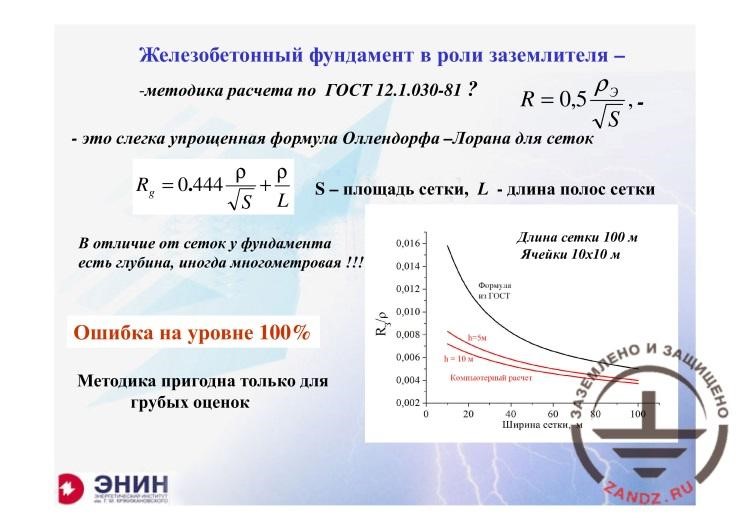
Reinforced concrete foundation as an earthing device
| Железобетонный фундамент в роли заземлителя - | Reinforced concrete foundation as an earthing device - |
| - методика расчета по ГОСТ 12.1.030-81? | - calculation method according to GOST 12.1.030-81? |
| - это слегка упрощенная формула Оллендорфа–Лорана для сеток | - this is a slightly simplified Ollendorff — Laurent formula for grids |
| S – площадь сетки, L – длина полос сетки | S is the grid area, L is the grid band length |
| Длина сетки 100 м | Grid length is 100 m |
| Ячейки 10х10 м | Cells of 10 x 10 m |
| Формула из ГОСТ | Formula from GOST |
| Компьютерный расчет | Computer calculation |
| Ширина сетки, м | Grid width, m |
| В отличие от сеток у фундамента есть глубина, иногда многометровая!!! | Unlike the grid, the foundation has its depth, which is sometimes several meters!!! |
| Ошибка на уровне 100% | Error of about 100% |
| Методика пригодна только для грубых оценок | The method is suitable for rough estimates |
– Good afternoon for everyone. I ask you to write in the chat if you can hear us and whether there are any problems with sound and video. I want to say that we are going to have an overview tour today, as Eduard Meerovich said. He will answer your questions. Moreover, you may ask additional questions in the chat during the discussion. I will also read them. Well, I can see that the participants ask to volume up the sound. We will try to do that. In any case, Eduard Meerovich, you may start.
– Good. I must tell you that no person can answer all questions in lightning protection. And I do not think that I am such a person. But I will try to study your questions related to the areas where I have an experience together with you. They have been structured for me. I will begin with the question that is interesting for many participants. I am talking about the reinforced concrete foundations as earthing devices. The question is like this. Can we calculate the parameters for this foundation according to GOST 12.1.030-81 that sets the use of reinforced concrete foundations as earthing devices. There are two questions. The first question is: a formula is provided that is shown on the right. I am showing it. Such formula is provided in this GOST as a formula for calculating the earthing resistance of the foundation. This formula does not contain anything except for the foundation area and the effective soil resistivity. And then, one more empirical formula is provided, using which we can calculate such effective soil earthing. What should I say regarding this? First, the Research Institute for Reinforced Concrete has studied the foundation condition for many years and determined the following point. Since cement is a hydrophobic medium, it absorbs moisture from the soil. As a result, after the foundation has been built, in two or three months, the foundation resistivity will not differ from the resistivity of the soil wherein this foundation is placed. As a result, the metal reinforcement of the foundation is kind of installed in a bare soil. And therefore, to calculate the foundation means to calculate the earthing device made of reinforcement rods. What formula is provided in GOST? Generally, it is a well-known Ollendorff — Laurent formula, from which an insignificant right term was eliminated and 0.444 was rounded to 0.5. Nothing else was done there. The Ollendorff — Laurent formula was used for calculating earthing devices in the form of flat grids. We studied this issue in the seminar that was dedicated to lightning arresters and earthing devices. And we showed there that the error of this formula is not high if you use it for flat grids. But the foundation is not a flat grid.
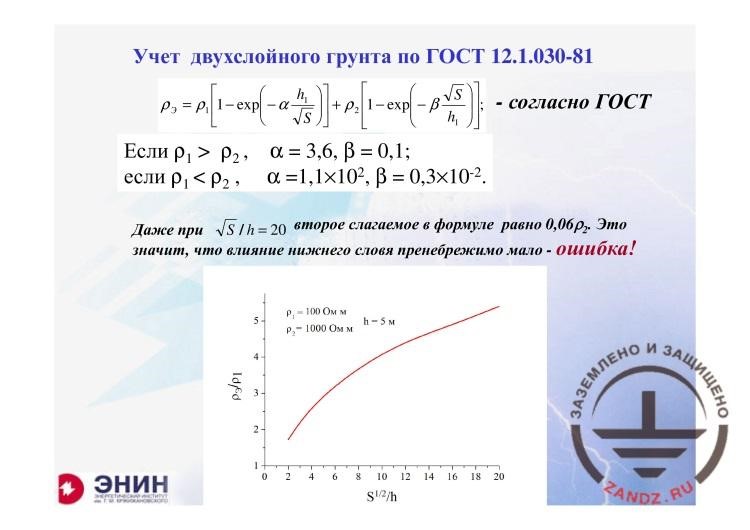
Considering a double-layer soil according to GOST 12.1.030-81
| Учет двухслойного грунта по ГОСТ 12.1.030-81 | Considering a double-layer soil according to GOST 12.1.030-81 |
| - согласно ГОСТ | - according to GOST |
| Если | If |
| Даже при | Even at |
| второе слагаемое в формуле равно 0,06ρ2. Это значит, что влияние нижнего слоя пренебрежимо мало – ошибка! | the second component of sum is equal to 0,06ρ2. It means that the bottom layer effect is negligible, which is an error! |
| Ом м | Ohm m |
| м | m |
– Here is what we can say about the formula itself. And the second point. This point is associated with that GOST 12.1.030-81 claims to ensure calculations for the earthing resistance of a foundation in a double-layer soil. And the empirical formula is provided as shown above; it is taken from this GOST. This formula yields wrong results. Actually, even if the relation of the square root and the foundation area at the depth where the second soil layer is located is 10–20, the adjustment provided by the formula is at most 3–6%. But in real life, the adjustment may be several times more. I would not recommend you to use the formula for calculations of the double-layer soil. But a rough estimate for the Laurent formula may be probably made.
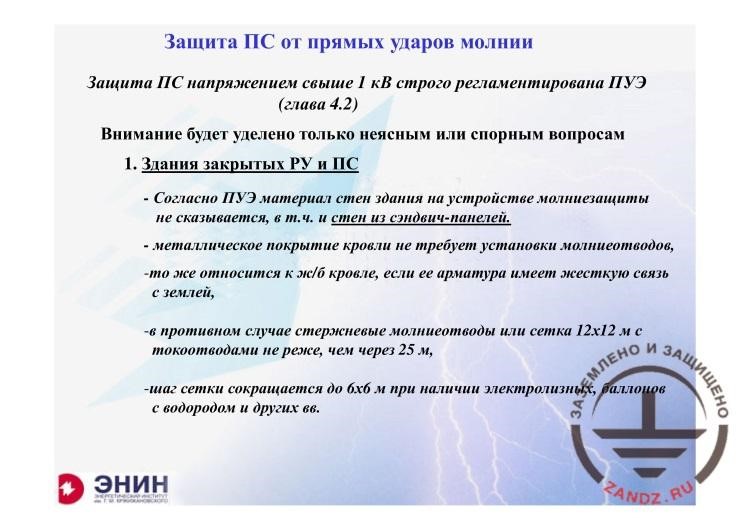
Substation protection against direct lightning strikes
| Защита ПС от прямых ударов молнии | Substation protection against direct lightning strikes |
| Защита ПС напряжением свыше 1 кВ строго регламентирована ПУЭ (глава 4.2) | Protection of a substation for over 1 kV is strictly governed by the EIC (Chapter 4.2) |
| Внимание будет уделено только неясным или спорным вопросам | Attention will be drawn to unclear and disputable issues |
| 1. Здания закрытых РУ и ПС | 1. Buildings of the closed distribution devices and substations |
| - Согласно ПУЭ материал стен здания на устройстве молниезащиты не сказывается, в т.ч. и стен из сэндвич-панелей. | - According to the EIC, the material of the building’s wall does not affect the lightning protection device, including the walls made of sandwich panels. |
| - металлическое покрытие кровли не требует установки молниеотводов, | - the metal roof coating does not require the lightning arrester’s installation, |
| - то же относится к ж/б кровле, если ее арматура имеет жесткую связь с землей, | - it also covers the reinforced concrete roof if its reinforcement has a hard coupling with the earth, |
| - в противном случае стержневые молниеотводы или стека 12х12 м с токоотводами не реже, чем через 25 м, | - otherwise, lightning rods or a grid of 12 x 12 m with the current collectors installed with a step of not less than 25 m, |
| - шаг сетки сокращается до 6х6 м при наличии электролизных, баллонов с водородом и других вв. | - the grid step is reduced to 6 x 6 m in the presence of an electrolysis unit, or the cylinders with hydrogen and other substances. |
– This is how I would answer the first question that is relevant for many people. In my opinion... I would recommend to avoid any calculations here. Build a building starting from its foundation. Measure the earthing resistance of its foundation and consider if it is suitable for you. If it is, you should not do anything else. If it is not and you should add some natural and some artificial earthing circuits, then decide on what you need to add. Therefore, generally, the calculations for the earthing resistance of the foundation, preliminary calculations, are not really needed. Now, the second question. All of my talks will be interrupted this way because questions differ significantly. Substation protection against direct lightning strikes. In general, I would have said nothing because we have the EIC with its Chapter 4.2, and this Chapter 4.2 details all issues for the protection of a substation with a voltage of over 1 kV. The only question we should discuss today is: what do we have to pay attention to in this EIC? Is everything provided there accurate? What we can or cannot use during the design? A particular question was as follows. It related to the closed distribution devices and substations. And one of the most particular questions was: how to make the lightning protection for the buildings of the closed distributions devices made of sandwich panels? It was a particular question. The point is that the requirements to the lightning protection contained in Chapter 4.2 are not associated with the material of the substation’s building. And if it is made of sandwich panels, then you have to protect such substation similarly to any closed substation according to Section 4.2. The second point is as follows. It states without any reservations that if the building roof has a metal coating, then the lightning arrester’s installation on the roof or near the building is not required. The roof may be used as a lightning arrester, provided that it is earthed. The same is true for the reinforced concrete roof.
| Эффективность сетки - | Grid efficiency - |
| - на проводящей кровле нулевая | - is equal to zero on a conductive roof |
| Вероятность прорыва | Breakthrough probability |
| Высота объекта, м | Building height, m |
| Здание 40х40 м2 | Building of 40 x 40 m2 |
| Сетка 10 х10 м2 превышает кровлю на 20 см | Grid of 10 x 10 m2 is higher than the roof by 20 cm |
– Now, look here. We have already intentionally studied the grids. And I take a graph from one of the webinars that shows how many strikes the grid misses when it is installed on the building roof. It turns out that for the buildings of 10 to 15 meters high, and it will be the distribution device building, about 30% lightnings will not see the grid at all. Therefore, there is no point in installing the grid on the building roof and hoping that it will protect the roof. And if possible, the EIC requirement in this case should be avoided. The more so that the EIC does not prohibit installation of additional lightning arresters. And I will get back to this issue later when I study the lightning protection of buildings.
| ПУЭ разрешает применение тросовых молниеотводов для защиты ОРУ - | The EIC allows the use of wire lightning arresters to protect the open distributions devices - |
| - но они фактически не используются на практике! | - but they are virtually not used in practice! |
| В чем преимущества тросов? | What are the wire advantages? |
| - обеспечение защиты территории ОРУ ПС 110 – 750 кВ от прямых ударов молнии с надежностью свыше 0,999; | - providing the protection for the 110–750 kV substation of the open distribution device against the direct lightning strikes with a reliability of over 0.999; |
| - снижение числа ударов молнии в территорию ПС примерно в 2,5 раза; | - reducing the number of lightning strikes into the substation territory about 2.5-fold; |
| - полная ликвидация опасных импульсных воздействий на цепи вторичной коммутации при растекании токов молнии в грунте на территории ПС; | - fully eliminating the dangerous pulse effects to the secondary commutation circuits upon the lightning current spreading in the soil within the substation territory; |
| - существенное ослабление воздействия электромагнитных наводок на микропроцессорную технику от тока в канале молнии и в грозотросах; | - significantly alleviating the effect of electromagnetic interference on the microprocessor hardware from the lightning channel and in the ground wires; |
– Let's go further. To protect the substation, it is generally allowed to use wire lightning arresters in addition to the lightning rods. But if you look at the Russian substations, you will not be able to see wire lightning arresters there. The entire lightning protection for substations is made via the lightning rods. If you ask the designers, "Why do you use lighting rods?" They will answer: "Why do I have to hang the lightning arresters over the substation buses? What if these wires break and fall down on them? We will have a short circuit there, the effects of which can be hardly predicted." And for this reason, the issue of providing the substation protection using the wire lightning arresters remains open. Although, frankly speaking, in the world practice, the use of wire lightning arresters for the substation protection is the thing of the past. It is because they are made in a number of countries. They are especially made in the regions with bad soils having high resistivity and where it is hard to make good earthing at the substation. Our Krzhizhanovsky Energy Institute, by the order of the Federal Grid Company, studied the protection of the substation using the wire lightning arrester, intentionally. What have we determined? We have determined the following point. That in all conditions, the wire protection is much more reliable than the protection using the lightning rods. It is not a problem to achieve the protection reliability of 0.999 of the entire substation territory using the wire lightning arresters. Why? That is why. It is because the wire lightning arresters in the electrical field of a thundercloud create a layer of bulk charge above them that shields the entire substation territory from the electrical field of the thundercloud. And as a result, the number of lightning strikes into the substation territory is reduced 2.5 to 3 times. Moreover, due to the fact that the supports of the wire lightning arresters may be located outside the substation territory, the lightning current received by the wires flows not within the territory but outside of it. As a result, the electromagnetic interference in the automation equipment to any secondary commutation circuits are significantly reduced. And this condition is a rather significant point to recommend the use of wire lightning arresters for the substation protection.
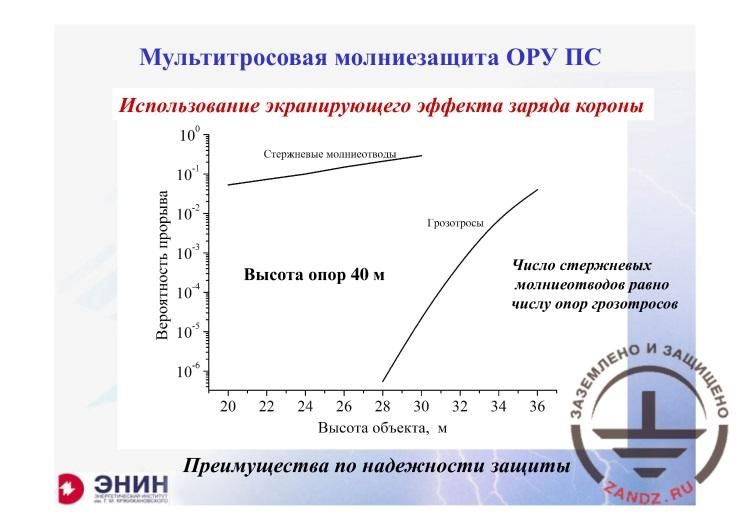
Multi-wire lightning protection for the open distribution device's substation
| Мультитросовая молниезащита ОРУ ПС | Multi-wire lightning protection for the open distribution device's substation |
| Использование экранирующего эффекта заряда короны | Use of a shielding effect of the crown charge |
| Вероятность прорыва | Breakthrough probability |
| Высота опор 40 м | Support height of 40 m |
| Стержневые молниеотводы | Lightning rods |
| Грозотросы | Ground wires |
| Высота объекта, м | Facility height, m |
| Число стержневых молниеотводов равно числу опор грозотросов | Number of lightning rods is equal to the number of the ground wire supports |
| Преимущества по надежности защиты | Advantages in terms of the protection reliability |
– And when the mechanical engineers are asked if they can make the wire attachment so that these wires would hang in the substation territory without breaking for about a hundred years. (Although the service life of the substation is much less). The answer is very simple. If you need to do that for ten wires of 200 to 300 meters long, it is not a problem at all. And I will show you that the wires are more efficient than the rods. Look at what has been done here. It is the wire protection efficiency. The facilities' height is plotted along the x-axis, and the wire is hung at the height of 40 meters. Can you see it? These are the rods, the number of them is equal to the number of supports for the wire lightning arresters. The protection reliability is about 0.9. And those are the wire lightning arresters that are hung on the supports that could have been rods. In this case, the protection reliability is less than 0.9. And in the practically significant conditions, it is less than 0.9999, i.e. it is a very high protection quality. Unfortunately, there is not the practical experience of using the wire lightning arresters in Russia yet.
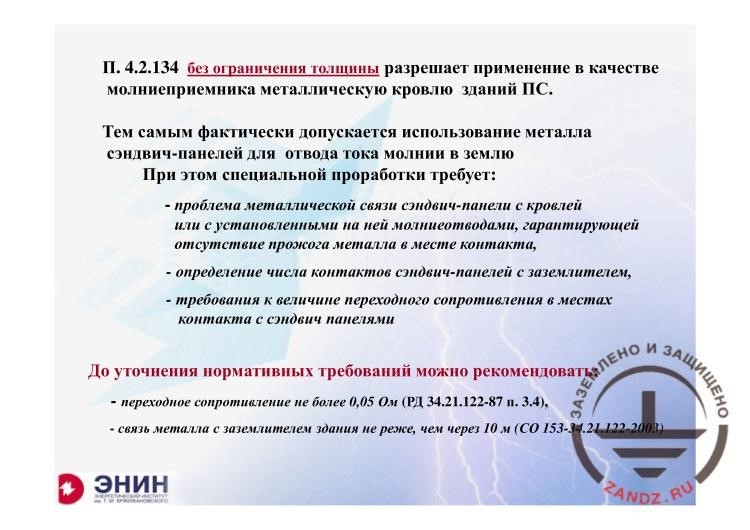
Using sandwich panels for draining the lightning current
| П. 4.2.134 без ограничения толщины разрешает применение в качестве молниеприемника металлическую кровлю зданий ПС. | Item 4.2.134 without the thickness limitation allows the use of the substation building’s metal roof as the lightning arrester. |
| Тем самым фактически допускается использование металла сэндвич-панелей для отвода тока молнии в землю | Thereby, the use of the metal of sandwich panels is actually allowed to drain the lightning current in the earth |
| При этом специальной проработки требует: | And the special consideration is required for: |
| - проблема металлической связи сэндвич-панели с кровлей или с установленными на ней молниеотводами, гарантирующей отсутствие прожога металла в месте контакта, | - the issue of metal coupling between the sandwich panels and the roof or the lightning arresters installed thereon, which ensures the absence of metal burning in the contact point, |
| - определение числа контактов сэндвич-панелей с заземлителем, | - the determination of the number of contacts of the sandwich panels with the earthing device, |
| - требования к величине переходного сопротивления в местах контакта с сэндвич панелями | - the requirements to the value of transient resistance in the contact points with sandwich panels |
| До уточнения нормативных требований можно рекомендовать: | Before clarifying the regulatory requirements, the following can be recommended: |
| - переходное сопротивление не более 0,05 Ом (РД 34.21.122-87 п. 3.4), | - transient resistance of not more than 0.05 Ohm (RD 34.21.122-87, item 3.4), |
| - связь металла с заземлителем здания не реже, чем через 10 м (СО 153-34.21.122-2008) | - metal coupling with the building’s earthing device with the step of not less than 10 m (SO 153-34.21.122-2008) |
– But its potential is very good. Now, I want to draw your attention and get back again to sandwich panels and metal profile on the roof. The EIC allows it. The EIC permits the lightning strike into the metal profile and the sandwich panels. What questions for the designer arise here? There are several of them. They have not been solved and described in the EIC yet. The first question is: how will the metal sandwich panel be connected to the roof? I mean, what communication elements will be used? How many of them should we use? And spaced at how many meters? And in what way? One point is clear. Welding cannot be used here because you can weld neither sandwich panels nor metal profile. It means that we should talk about bolt clamps. The requirements to these bolt clamps have not been specified in Russia unlike other countries. They have to be specified. The second point. It is the following question. And in what points the sandwich panels should be connected to an earthing device? Spaced at how many meters? It is unknown yet. And finally, the requirements to the transient resistance in the location of the sandwich panel connection to the roof made of a metal profile. These issues are also absent. What do the designers have to do today? Today, the designers may do the following thing. RD 34 states that when it is impossible to use welding for connection, it is permitted to make a bolt connection with the resistance of not more than 0.05 Ohm. This RD 34 requirement has not been cancelled.
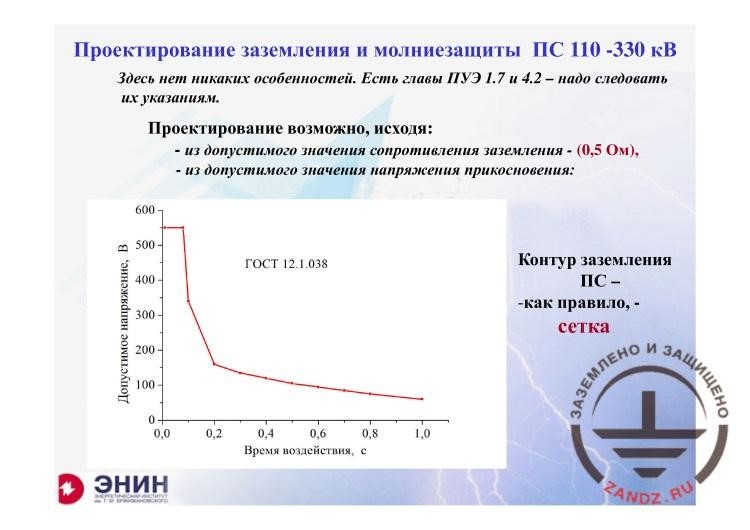
Designing earthing and lightning protection for the 110–330 kV substation
| Проектирование заземления и молниезащиты ПС 110-330 кВ | Designing earthing and lightning protection for the 110–330 kV substation |
| Здесь нет никаких особенностей. Есть главы ПУЭ 1.7 и 4.2 – надо следовать их указаниям. | There are no features here. Chapters 1.7 and 4.2 of the EIC exist and we have to follow their directions. |
| Проектирование возможно, исходя: | Design is possible based on: |
| - из допустимого значения сопротивления заземления – (0,5 Ом), | - the allowable value of the earthing resistance — (0.5 Ohm), |
| - из допустимого значения напряжения прикосновения: | - the allowable value of the touch voltage. |
| Допустимое напряжение, В | Allowable voltage, V |
| ГОСТ 12.1.038 | GOST 12.1.038 |
| Время воздействия, с | Exposure time, s |
| Контур заземления ПС – как правило, - сетка | Substation earthing circuit is usually a grid |
– One more question regarding the substation's lightning protection. For some reason, the question refers to 110–330 kV. But I would say that these questions refer not to 110–330 kV, but rather to 110–500 kV, because there is virtually no 750 kV line in Russia. In this case, we also have to follow the EIC instructions. There is Section 1.7 about the earthing devices. There is Section 4.2 I have already referenced to. It generally states everything. It states everything but it is hard to implement for the following reason. It states as follows. You may design the earthing devices for the substation based on two considerations. The first consideration is that the earthing resistance of the earthing circuit of the substation should be not more than 0.5 Ohm. It is clear. Second. The allowable touch voltage should meet the requirements in the standard. Which of them? It is an important issue for the following reason. There are such requirements. They are marked on the graph below in this slide. They depend on how much time the touch voltage lasts. And the shortest time we have is 0.01 second. The graph is brought to zero, but the minimum time indeed is 0.01 second. And the storm surges take not 0.01 second but rather 100 microseconds. It is one hundred times less. So, if you have planned to design the substation's lightning protection according to the allowable touch voltage, what will you use? You have no data. Such data are absent in any regulatory document that is effective in Russia. And therefore, such desire to design the earthing circuit according to the touch voltage exists only in papers.
Next page >>
slides from 10 to 18
Related Articles:

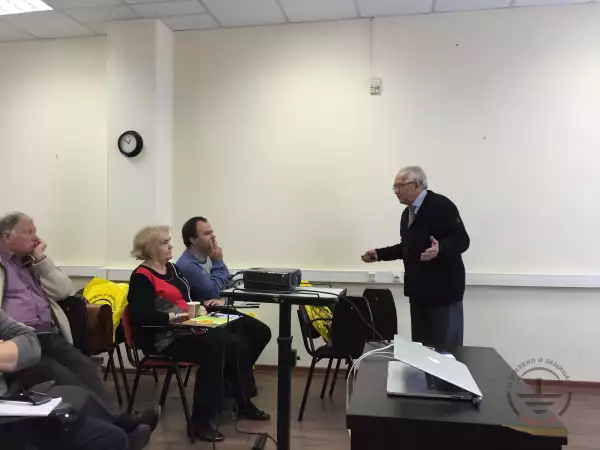
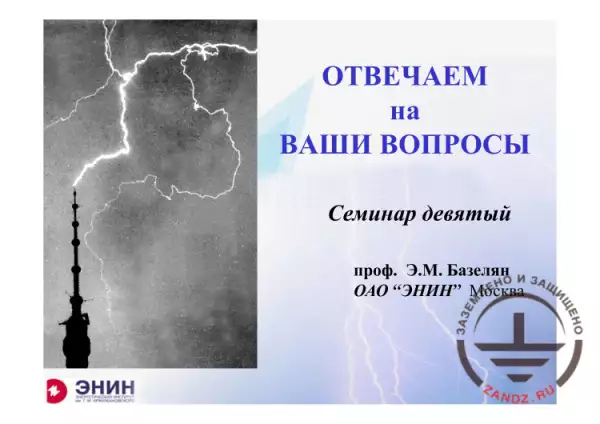 Webinar titled "Answers to Your Questions Regarding Earthing and Lightning Protection" Page 2
Webinar titled "Answers to Your Questions Regarding Earthing and Lightning Protection" Page 2
 Webinar titled "Answers to Your Questions Regarding Earthing and Lightning Protection". Page 3
Webinar titled "Answers to Your Questions Regarding Earthing and Lightning Protection". Page 3



